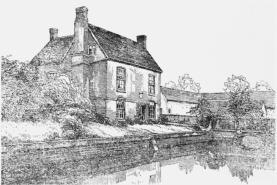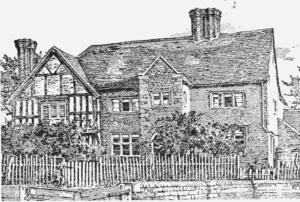gteetihotetiguihhoeiuiugt
Quote of the Day






© Benefice of Belbroughton, Fairfield
History
HISTORICAL
Moor Hall, Belbroughton
Fairfield Court
BELBROUGHTON
The Imperial Gazetteer of England & Wales 1870
Belbroughton, a manor, a parish, and a subdistrict, in the district of Bromsgrove, Worcester. The manor lies 4 ¼. miles
S by E of Stourbridge r. station, and 5 NW of Bromsgrove; and has a post office under Stourbridge, and fairs on the last
Monday of April and the second Monday of Oct. The parish includes also the manors of Fairfield, Bromhill, and Brian’s
Bell, and the village of Hartle. Acres, 4,605. Real property, £11,450. Pop., 1,995. Houses, 405. The property is much
subdivided. An extensive manufacture of scythes, hayknives and many kinds of edge-tools, is carried on. The living is a
rectory in the diocese of Worcester. Value, £1,244. Patron, St. John’s college, Oxford. The church is old but good; and
there are Wesleyan and Primitive Methodist chapels. A school has an endowed income of £10, and other charities £24.
The subdistrict comprises five parishes and part of a sixth. Acres, 15,584. Pop., 4,867. Houses, 1,053.
Source: The Imperial Gazetteer of England & Wales [Wilson, John M]. A. Fullarton & Co. N. d. c. [1870-72].
Worcestershire Delineated C. and J. Greenwood 1822
Belbroughton – a parish in Halfshire hundred, lower division, 3 miles N.N.W. from Bromsgrove, and 117 from London;
containing 311 inhabited houses. It is a parish of considerable extent, and has 2 annual fairs, viz., the first Monday in
April, and the Monday before St. Luke’s, (18th October). Here are several manufactories for scythes and other articles
in the iron trade; and a sheriff’s court is held every third Wednesday in the month, for the recovery of small debts. The
living is a rectory; Rev. G. F. Blackiston, D.D., incumbent; instituted 1798; in the gift of St. John’s College, Oxford.
Population, 1801, 1266 – 1811, 1318 – 1821, 1476. Bell-Hall, in the parish of Belbroughton, 3 miles from Bromsgrove,
the residence of Mrs. Noel.
Source: Worcestershire Delineated: Being a Topographical Description of Each Parish, Chapelry, Hamlet, &c. In the
County; with the distances and bearings from their respective market towns, &c. By C. and J. Greenwood. Printed by T.
Bensley, Crane Court, Fleet Street, London, 1822.
A Topographical Dictionary of England 1848
Belbroughton (Holy Trinity), a parish, in the union of Bromsgrove, Lower division of the hundred of Halfshire,
Stourbridge and E. divisions of the county of Worcester, 5 miles (N. W. by N.) from Bromsgrove, on the road to
Stourbridge; containing 1765 inhabitants. The parish is divided into the manors of Belbroughton, Brian’s Bell, Fairfield,
and Broomhill. It comprises 4733 acres, of which a considerable portion is pasture land; the soil is fertile, producing
wheat, barley, turnips, &c.; the surface is rather hilly. The manufacture of hay-knives and scythes is carried on
extensively; and fairs take place on the last Monday in April, and the Monday before St. Luke’s day. Mr. Rufford, banker,
has a mansion here. The living is a rectory, valued in the king’s books at £19; net income, £1244; patron, the President
and Fellows of St. John’s College, Oxford. The church is a handsome structure, with a tower and spire; it stands on the
south-west side of the village, on the eastern bank of a good stream of water, which turns several mills. There is an
endowment of about £10 per annum for the instruction of children. In 1833, a Roman jar, containing more than a
hundred coins of the early emperors, was found on the Fern estate, near Fairfield.
Source: A Topographical Dictionary of England by Samuel Lewis 1848.
FAIRFIELD
Imperial Gazetteer of England and Wales Circa 1870
Fairfield, a manor in Belbroughton parish, Worcester; 3 ¼ miles N of Bromsgrove. It forms a curacy with Belbroughton;
and has a post-office under Bromsgrove.
Source: The Imperial Gazetteer of England & Wales [Wilson, John M]. A. Fullarton & Co. N. d. c. [1870-72].
CLENT
The Parliamentary Gazetteer of England and Wales 1851
Clent, a parish formerly in the south division of the hund. of Seisdon, union of Bromsgrove, county of Stafford, but
included in Worcestershire, to which county it is now annexed; 3½ miles south-south-east of Stourbridge. Living, a
vicarage with the perpetual curacy of Rowley Regis, in the archd. and dio. of Worcester; rated at £8 16s. 5½d.; gross
income £446. Patron, the Lord-chancellor. There are places of worship here for the Baptists and the Wesleyan
Methodists. The Baptist church was formed in 1802. This parish possesses 2 daily and 3 infant schools, besides 2
charity-schools, one of which is a Sunday school with an endowment, in 1820, of £21 19s. 6d. per annum; and the
other a day school with an endowment of £8. The church lands in this parish yielded, in 1820, an annual rent of £67
3s.; Maris and Cole’s charity to the poor, an income of £35; and minor charities £8 7s. Acres 2,520. Houses 188. A. P.
£4,337. Pop., in 1801, 738; in 1831, 922. Poor rates, in 1838, £336 10s.
Source: The Parliamentary Gazetteer of England and Wales; A Fullarton & Co. Glasgow; 1851.
The following extract comes from British History Online:
BELBROUGHTON
Broctune (ix cent.); Brotune (xi cent.); Bellenbrokton (xiv cent.).
The parish of Belbroughton has an area of 4,748 acres, comprising, in 1905, 2,012¾ acres of arable land, 2,195½
acres of permanent grass and 321½ acres of woodland. It occupies the lower slopes of the Clent range, its height
varying from 332 ft. on the western border to 700 ft. in the extreme northeast. The village is situated close to the
western border of the parish. The church stands on high ground on the west side of the by-road running south out of
the settlement. Immediately opposite is the rectory, a plain three-story red brick building of the late 18th century, to the
north of which stands the old tithe-barn, now in a very dilapidated condition and shortly to be pulled down to make room
for a parish hall. The cottages are of no great antiquity and are mostly of red brick, although half-timber construction is
also to be seen; they are generally roofed with tiles. At the northern extremity of the village, at the junction of the roads
from Holy Cross and Bell End, is the 'Talbot,' a small late 17th or early 18th-century inn built of red brick and having a
tiled roof. It is of no architectural interest, but the stables which are attached to the building on the east, and are of the
same date (though built of stone), merit attention on account of the attempt at symmetry displayed in the design of their
elevations.
The greater part of the Bell Inn at Bell End was rebuilt late in the 17th or early 18th century, though parts are of much
earlier date. It is of L-shaped plan, two stories high, and is built of red brick with a tile roof; the older walls are, however,
of half-timber construction. The interior has been completely modernized. The windows are divided into lights by
wooden transoms and mullions. This is one of the many inns in which King Charles is incorrectly said to have rested in
his flight from Worcester.
Moor Hall, now a farm-house, is situated a little way off the east side of the Bromsgrove and Stourbridge road. It was
surrounded by a moat, now filled in on the north and east sides. The house, which was erected late in the 17th century,
is of two stories and built of red brick with a tiled roof. It is of little architectural interest, having been added to on the
north-east and completely modernized in the 19th century. Over the entrance doorway is a small stone panel inscribed
with the following: 'Non Domus Dominum sed Dominus Domum Honestat, I[.] T[.] [E ? / L ?] 1680.'
Fairfield Court stands back on the west side of the Bromsgrove and Stourbridge road, about 5 miles north of the latter
town. It is now a farm-house, and until recent years was entirely surrounded by a moat, access to the house being
obtained by a drawbridge, but all traces of this have now disappeared and the moat along the north side of the building
has been filled in. The principal front of the house, with the porch, faces north and two wings project southward from
the rear of the building. To the original house, probably erected early in the 16th century, belong the whole of the east
end of the building and the central chimney stack in the middle of the western portion, but most of the remainder of the
structure was entirely rebuilt in the early part of the following century and remains in a good state of preservation. In the
18th century the ends of the east wall of the eastern wing were refaced with red brickwork and about the same time the
dairy (adjoining the south-west corner of the house) was erected, while the modern work consists of the outhouse at
the end of the dairy and various minor alterations.
ADVOWSON
There were a church and priest at Belbroughton in 1086, (fn. 123) and the advowson was annexed to the manor of
Belbroughton and Fairfield until about 1595, (fn. 124) when the manor was sold by John Talbot. He retained the
advowson and died in 1607, when it passed to his son John, (fn. 125) by whom it was sold in 1624 to Thomas Tristram,
clerk. (fn. 126) Between this date and 1731 the presentations were made by various people, (fn. 127) who were
probably feoffees of the Tristrams, for in 1731 Bridget Tristram presented to the church, (fn. 128) and in 1733 she sold
the advowson to the President and scholars of St. John's College, Oxford, (fn. 129) with whom it has since remained.
(fn. 130) Dr. Gibbons, of St. John's College, gave £1,000 and his widow £300 of the purchase money. The advowson is
subject to the condition that 'the person to be presented from time to time shall be one of the fellows of the college who
has been or is at such time Dean of Divinity in the said college.' (fn. 131)
St. Mark's chapel of ease was erected at Fairfield in 1854.
¶
There is a Primitive Methodist chapel at Belbroughton.
For more see: http://www.british-history.ac.uk/vch/worcs/vol3/pp11-19













